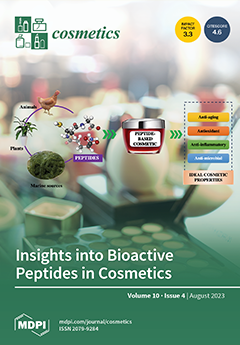In recent decades, there has been a growing demand for shampoos derived from botanical sources due to their avoidance of synthetic and highly allergenic chemicals used as bioactives and excipients. These hair care products are free from sulfates, parabens, silicones, synthetic fragrances, and
[...] Read more.
In recent decades, there has been a growing demand for shampoos derived from botanical sources due to their avoidance of synthetic and highly allergenic chemicals used as bioactives and excipients. These hair care products are free from sulfates, parabens, silicones, synthetic fragrances, and artificial colours. Natural shampoos are sustainable, skin-friendly, and eco-friendly to the environment.
Garcinia mangostana (Mangosteen) peel is usually discarded as agricultural waste. It consists of numerous bioactives which exhibit promising activities for hair care and scalp maintenance. This study aimed to formulate and evaluate a novel hair shampoo containing standardised mangosteen peel extract. The formulation of the mangosteen shampoo utilised botanical ingredients and naturally derived components. It underwent an evaluation to assess its physicochemical properties, including visual inspection, pH, surface tension, percentage solid content, wetting time, foam ability and stability, as well as dirt dispersion. These properties were then compared to those of two commercially available hair shampoos. Its antimicrobial activity towards
Malassezia furfur ATCC 14521 and
Staphylococcus aureus ATCC 25923 was also examined and compared with the commercial shampoo using the microbroth dilution method. Its antioxidant activity was evaluated using 2,2-diphenyl-1-picrylhydrazyl (DPPH) free radical scavenging activity assay. It was noticed that all formulations (F1–F4) had acceptable physicochemical properties, and they fell within the standard range. F2 had the best antifungal activity (MIC 0.039 mg/mL, MFC 0.156 mg/mL), and moderate antibacterial (MIC 2.50 mg/mL, MBC 5.00 mg/mL) and antioxidant activities (IC
50 21.9 ± 3.27 mg/mL; AEAC 26.3 ± 4.06 mg AA/100 g sample). A microscopic examination of hair strands after washing revealed the successful removal of artificial sebum, signifying a good detergency effect. The physical and chemical properties of the hair shampoo formula remained stable without phase separation. In conclusion, the formulated clean hair shampoo with standardised mangosteen peel extract has good cleansing properties, and it is effective in inhibiting dandruff-causing microbial and scavenging free radicals.
Full article





